
|
|
Exchanging Values via "exclusive-or"s |
|
|
A formal proof that three "exclusive-or" operations will exchange the values contained in two memory cells, using techniques from the The Calculus of Indications Boundary Mathematics The Calculus of Indications is now addressed by this branch of Mathematics. Principia Cybernetica Web This project addresses the larger issues of consciousness. Java meets The Laws of Form Java is another instance where the External and Internal Forms of an Object are identical. |
||
The
![]() of a Non-Numerical
Arithmetic
is the intellectual concept of the "Existence of
Objects",
whether the
Objects
are real or imagined. Needless to say, any such discussion of existential import ultimately has a spiritual genesis.
of a Non-Numerical
Arithmetic
is the intellectual concept of the "Existence of
Objects",
whether the
Objects
are real or imagined. Needless to say, any such discussion of existential import ultimately has a spiritual genesis.
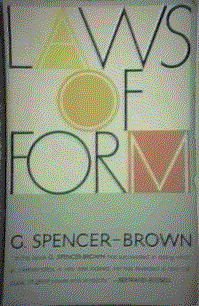 The algorithms for indicating existence may have a
The algorithms for indicating existence may have a
![]() which is either
Experiential
or
Representational.
which is either
Experiential
or
Representational.
The discussion which follows is based on the work of Mr. G. Spencer-Brown which was first published in 1969 under the title "The Laws of Form". Regarding this work, Bertrand Russell commented that:
In the "The Laws of Form", Spencer-Brown develops the axioms, canons, conventions, and other formalisms necessary to construct what he calls the Calculus of Indications, in a completely rigorous manner. This Calculus of Indications may be immediately interpreted as a Boolean Arithmetic.
The development and application of the Calculus of Indications is divided into the following sections:
Finally, the kind reader can always refer back to the discussion of Numerical Arithemetic.
In order to fully appreciate what is going on here, The Homeless Mathematician must inform the kind reader that what they may have thought of as Boolean Algebra is actually a grand misnomer and incorrect usage of the term "Algebra".
What is commonly called Boolean Algebra is actually a collection of discrete function tables which represent the behavior of arbitrarily defined functions called "conjunction", "disjunction", "implication", "negation", etc. For example, consider three of the most common so-called Boolean Functions:
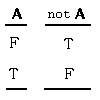
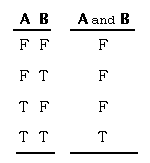
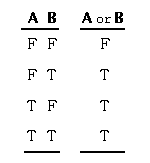
Notice that the above functions are formally represented as Boolean Operators in a Boolean Expression which has a
![]() that
that
![]() s
a strong
s
a strong
![]() to the
to the
![]() of an Arithmetic Expression. This is a convenient use of symbolic
of an Arithmetic Expression. This is a convenient use of symbolic
![]() s. However, it is formally incorrect to do this because such
s. However, it is formally incorrect to do this because such
![]() s import the
s import the
![]() of Arithmetic Operators instead of the
of Arithmetic Operators instead of the
![]() of the Boolean Functions. The actual
of the Boolean Functions. The actual
![]() of a Boolean Operator must import the actual
of a Boolean Operator must import the actual
![]() of the Boolean Operator. The
External and Internal Forms
may differ, but the
of the Boolean Operator. The
External and Internal Forms
may differ, but the
![]() must be preserved in order for it to be experienced.
must be preserved in order for it to be experienced.
Every philosophy and computer science student has has to memorize these tables at some time or other. Having memorized these tables, there is a classic exercise that involves proving deMorgan's Laws, namely:
This usually involves
an exhaustive substitution of
the possible Boolean Operands,
F for "false" and T for "true",
which the Boolean Variables,
A and B,
may assume.
For each such substitution, the above tables are then applied to evaluate each side of the equation. If both side match for each substitution, then the relationship has been proved by exhaustion.
The fact is that there was no formal calculation involved in this proof, only functional evaluation based on an explicit enumeration of values. While the Boolean Operands, F and T, may form an Arithmetic, there are no Boolean Operators. Conjunction, disjunction, and negation are Boolean Functions, but they are not formal Operators. Imagine attempting to perform Numerical Arithmetic in the same way that the Boolean Arithmetic for the above proof was done. That is to say, consider the numerical equation:
Proof by exhaustion is impossible. The kind reader could check this out by substituting all positive integers less than, say, one million, and then recall there are a lot of integers left to check out. Because "-" and "+" are Arithmetic Operators which have the property that:
a proof of the above Algebraic Equation ( given the underlying Numerical Arithemetic ) is almost trivial. An Arithmetic requires Operators for calculation, and the classic logic tables define Boolean Functions, not Operators. Although the deMorgan's Law is, in fact, true, it is not a Boolean Algebraic Equation. A more proper formulation for deMorgan's Laws is:
where not( * ), or( *, * ), and and( *, * ), designate the usual Boolean Functions.
At this stage, kind reader, it is the time, here and now to gaze on the what are called the Initials of the Arithmetic. For our common, day-to-day Numerical Arithemetic, the Initials are
For the Calculus of Indications, the Initials may be written, variously, as:
![]()
For formal discussions, this is the perfered form to indicate the Marked State.
![]()
![]()
These Initial forms of the Mark allow Number and Order.
![]()
![]()
Any visual form which
indicates a distinction between, say,
an internal and an external space,
has a strong
![]() of
of
![]()
which preserves the
![]() of the Mark of Distinction.
of the Mark of Distinction.
![]()
![]()
Since curly brackets have an inside and an outside
it is possible to create great confusion
by mistaking the mathematical Set Notation of
writing "{ }" to indicate the Null Set
and, hence, writing { } = .
How silly.
Remember that a Mark is not Null.
There is a strong
![]() of
of
![]() which preserves the
which preserves the
![]() of between the Calculus of Indications and the Boolean Operands and the "not" function. The kind reader will find this to be true, beyond any doubt, as they gaze at the actual visual
of between the Calculus of Indications and the Boolean Operands and the "not" function. The kind reader will find this to be true, beyond any doubt, as they gaze at the actual visual
![]() of the Initials.
of the Initials.
The Initials of a Non-Numerical Arithmetic can be used as the underlying Arithmetic for a formal Algebra as detailed in the following table. Each of the 16 possible Boolean Functions of two variables are expressed as a visual combination of elements of the Initials, with Formal Parameters assuming either a Marked or Unmarked Operand. Just imagine that if something is Marked, then it must exist - otherwise it could not be Marked; if something is Unmarked, then it does not exist and, literally, nothing can be seen. The Boolean Functions are indexed from 1 thru 16, for later reference.
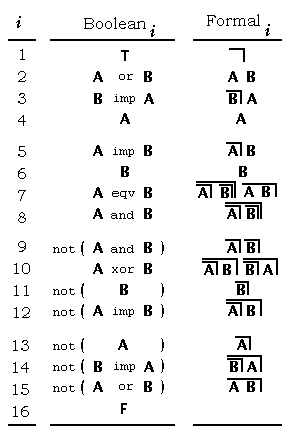
The explicit
calculation,
for two of the simplest functions are as follows. Notice the strong
![]() between the Boolean Operands of "false" and "true" with the Marked and Unmarked States.
between the Boolean Operands of "false" and "true" with the Marked and Unmarked States.
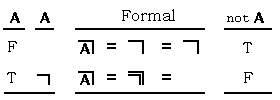
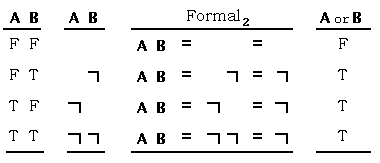
An example that requires more steps in the explicit calculations, is give by a demonstration of evaluating the classic conjunctive function, namely:
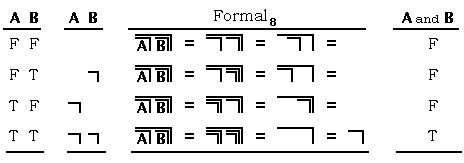
The kind reader is invited to test evaluate a few of these Arithmetic Expressions of a Non-Numerical
![]() .
At this point,
The Homeless Mathematician
will note that the problem with
A Non-Numerical Arithmetic that Failed
is that there are no Initials with which to form an Algebra.
.
At this point,
The Homeless Mathematician
will note that the problem with
A Non-Numerical Arithmetic that Failed
is that there are no Initials with which to form an Algebra.
Given the formal equivalency and
![]() between
between
The kind reader is requested to consider the following pair of Arithmetic Expressions:
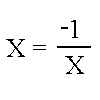
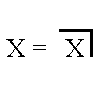
In the first case, the equation yields what are called the Imaginary Roots of the Real Number whose value is the negation of "one". Now, in physical measurements, Real Numbers are used to enumberate values of substance which we experience directly and can measure. Imaginary Roots enter into most equations which describe physical events and, in turn, have an indirect effect on the process. Consider the equations of X-ray diffraction in crystals. The precision of these equations allow us to resolve the location of indivdual atoms with in a Unit Cell of the crystal. The Homeless Mathematician wonders how many New Age crystal junkies can identify any of the 230 different space groups of synmetry which can form a crystal.
In any case, the strong
![]() among all
Arithmetics
can be used to solve the second equation.
Since it comes from the Calculus of Indications, the strong
among all
Arithmetics
can be used to solve the second equation.
Since it comes from the Calculus of Indications, the strong
![]() argues for Imaginary Roots also. In this case, the Imaginary Roots apply to a Marked State of Distinction, as indicated. Hence, the kind reader must now imagine Imaginary Marks.
argues for Imaginary Roots also. In this case, the Imaginary Roots apply to a Marked State of Distinction, as indicated. Hence, the kind reader must now imagine Imaginary Marks.
The strong
![]() between the Calculus of Indications and the Boolean Functions argues for what might be called Imaginary Boolean Operands. Thus, "T" and "F" should be called Real Boolean Operands, in distinction from Imaginary Boolean Operands which are neither "true" nor "false".
between the Calculus of Indications and the Boolean Functions argues for what might be called Imaginary Boolean Operands. Thus, "T" and "F" should be called Real Boolean Operands, in distinction from Imaginary Boolean Operands which are neither "true" nor "false".
While we can visualize the forms for the
![]() to a Marked and Unmarked State as a Real Boolean Operand, we can not visualize the form for an Imaginary Boolean Operand.
to a Marked and Unmarked State as a Real Boolean Operand, we can not visualize the form for an Imaginary Boolean Operand.
This is the Canonical
![]() of Distinction which results from the
of Distinction which results from the
![]() of Distinction. The distinction can have an
Object
as Marked or UnMarked, indicating existence or non-existence.
of Distinction. The distinction can have an
Object
as Marked or UnMarked, indicating existence or non-existence.
In addition, there are two states which may or may not interact with the
![]() of existence or non-existence, at a meta-level. At such a meta-level, the question of existence is irrelevant until an
Object
is again Marked or Unmarked.
of existence or non-existence, at a meta-level. At such a meta-level, the question of existence is irrelevant until an
Object
is again Marked or Unmarked.
Finally, to summarize, any Distinction has a
![]() ,
such that:
,
such that:
The Canonical Form of Distinction has many, many immediate and direct applications for clarifying the Form and Substance of Objects. For example:
and many more topics which will be added in the future.